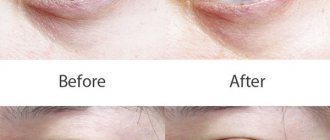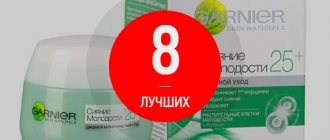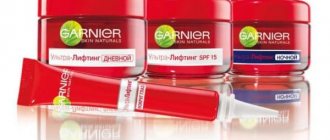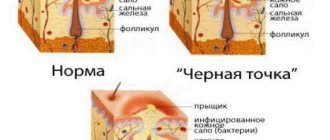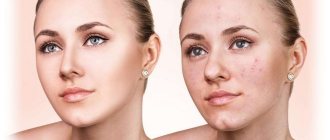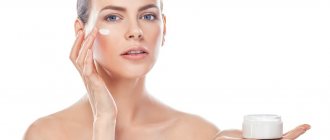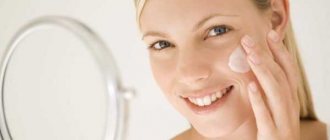Answers Doctor of Medical Sciences, Head of Department of the Institute of Plastic Surgery and Cosmetology Anna Stenko:
— There is no universal cream that would be effective for all women. The skin of each of us needs personal care - cleansing, moisturizing, nutrition, and at different ages - different components.
Article on the topic Delicious cosmetics. Why is yogurt added to creams and lotions?
Typically, women begin to regularly use cosmetics by the age of 30. At this age, neither miraculous remedies nor “shock artillery” are needed - for daily care, ordinary high-quality cosmetics are sufficient, the use of which eliminates the feeling of tightness and irritation, smoothes out superficial wrinkles, evens out skin tone, and gives it a healthy glow.
The first wrinkles in the corners of the eyes can be smoothed out using a special cream for this area.
To lighten isolated pigment spots, for example, those that appeared during pregnancy, you should use skin lightening products.
The use of anti-aging cosmetics is not limited to a specific age; you need to think about it when specific problems appear - facial wrinkles, age spots, decreased tone, uneven skin texture. Anti-aging cosmetics differ from conventional ones in their high concentration of active ingredients and their ability to penetrate into the deep layers of the skin.
Article on the topic
Cream is more expensive than gold. What secrets does luxury cosmetics hide?
What does the skin need?
15 years. A period of hormonal changes in the body and the formation of skin type, accompanied by increased sebum production. A complete cleansing is required - alcohol lotions and special soap. Regular facial cleansing and light moisturizing creams are recommended.
25 years. The main attention is to proper cleansing (including deep cleansing) and moisturizing. Light peelings, cleansing and moisturizing masks are recommended 1-2 times a week (depending on skin type). The main creams at this age are moisturizing and light nourishing.
35 years. Skin requires regular care. It is better to use creams with “special additives” - hyaluronic acid, nutritional.
45 years. Time for a professional facial. It is better to use creams labeled “regenerating” (slowing down the aging process of the skin).
55 years. The age of maturity, hormonal changes occur in the body, the skin becomes dehydrated, becomes flabby, and facial contours become blurry. We need special care products with a lifting effect, intensely moisturizing and nourishing serums.
“Golden your face.” Expensive creams that will not bring a noticeable effect Read more
Why do we need cream?
How to enhance its effect
It is supposed to be taken out using a special spatula, but applied using fingers and even the entire palm, since our hands are the best tool for gentle self-care.
Here are three reasons to combine the application of cream with a light massage: improved blood circulation promotes rapid penetration of components into the skin; gentle touches, performed slowly and consciously, help relieve psycho-emotional stress; sensual pleasure from texture, tactile sensations and aroma allows you to more fully use the emotional bonuses that are intended by the creators of the cream. Some massage techniques have proven themselves so well that schemes for their implementation are included in a box of cream. We invite you to try some of them.
Point stimulation
It is based on the Orchidee Imperiale technique, a version of Guerlain’s signature massage (this technique of lymphatic drainage and facial modeling using rhythmic pressure on certain points is seven decades old).
Technique: perform several intense pressures on points in the center of the chin and between the eyebrows; Perform point pressure on the upper part of the forehead parallel to hair growth, then parallel to the eyebrows, from the center of the face to the temples. Using medium-intensity pressure, move from the wings of the nose to the cheekbones and from the corners of the eyes to the earlobes, then (lightly) along the upper and lower eyelids from the bridge of the nose to the temples and from top to bottom along the nasolabial folds.
Effect: drainage, smoothing, stimulating, strengthening.
Light tingling sensations
It is based on a technique developed in Chanel laboratories (CE. RIE S) and knowledge about the structure of facial tissues from plastic surgery. Performed before applying Chanel Ultra Correction cream, using special gloves, it promises a powerful anti-aging effect.
Technique: Perform deep, repeated pinching in the forehead area - always perpendicular to the direction of the wrinkles from the center to the periphery. Then - short pinches perpendicular to the eyebrow fold. Using sliding pinching movements, smooth out crow's feet and nasolabial folds. Perform deep (stimulating) pinching in the cheekbone area and complete the procedure with deep pressure from the chin to the temples along the jaw line - simultaneously with the backs of both hands folded into a “handful”.
Effect: relieving muscle tension, smoothing wrinkles, restoring facial contours.
Smooth pressure
It is based on a rejuvenating massage technique developed by the Clarins Institute, which enhances the effect of the cream for the neck and décolleté.
Technique: Warm the product in your palms and apply to your neck. Then place your left hand on the right side of your neck and, applying light pressure, move it towards your shoulder. Repeat several times, then place your right hand on the left side of your neck and do the same movements. Place your hand at the base of your neck and apply light pressure with your palm, moving across your chest to the level of your bust.
Effect: restoration of skin elasticity and tone, reduction of wrinkles.
Ekaterina Smokina
The most effective cosmetic ingredients
Snail slime. Creams containing snail mucus are designed to combat scars, stretch marks and acne. Also, cosmetics with snail mucus restore damaged tissue, fill wrinkles, and improve the appearance of the skin.
Vitamin A. Also promotes collagen synthesis, increases skin firmness and elasticity.
Urea. A compound of ammonia and carbon dioxide is used in cosmetics as an effective moisturizer. It also improves skin permeability, which helps deliver the necessary components to the desired depth.
Article on the topic
Rejuvenate with poison. Why are mucus, droppings and caviar used in cosmetics?
Vitamin C promotes the synthesis of complete collagen and evens out skin pigmentation.
Caviar. One third consists of easily digestible protein, similar in structure to human protein. Its use helps stimulate the growth of collagen fibers. Caviar also contains polyunsaturated omega-3 acids, vitamins A, D, E, sodium, potassium, magnesium, and phosphorus. Used as a moisturizer and nourisher.
Aloe vera. An effective moisturizer, indispensable for sensitive skin prone to allergic reactions. Lightens age spots.
Hyaluronic acid is extracted from animal and plant tissues and is similar in structure to human ones. Forms a thin film on the surface of the skin, which retains natural moisture and fills wrinkles (due to this they become less noticeable). It is considered one of the most effective moisturizers (one molecule of hyaluronic acid binds and retains up to 500 molecules of water). It is used to correct age-related changes in the skin, restores skin elasticity, fights dryness, prevents the formation of wrinkles and folds, improves its appearance, and promotes deep and long-lasting hydration of the skin.
Placenta. The main ingredient in anti-aging creams, which promotes rapid regeneration and moisturizing of the skin. Cosmetics use animal placenta - the proteins, minerals and vitamins it contains are similar to human ones, which ensures their good absorption.
Important
All ingredients are listed on the label in descending order. If the component you are interested in is listed last, it means that it is contained in such a small amount in the cream that there is no need to talk about its radical effect on the skin.
Cosmetic problems. What vitamins does our skin need? More details
Other applications
The universal effect of the ointment allows you to treat gynecological diseases. Doctors often recommend the drug for healing ruptures and tightening of sutures.
1. It is practiced for hemorrhoidal cones. Means:
- restores damaged areas;
- strengthens the immune system;
- relieves inflammation;
- heals cracks.
The ointment is used twice a day. It is applied to the bumps and spread on the skin around them.
2. For the treatment of acne. The ointment has a wound-healing effect; it can be used to treat various rashes and suppurations. These are ordinary acne on the face. Quite often they appear in teenagers. The cream does not guarantee absolute health, but the overall condition of the skin can significantly improve. The only drawback is the fatty mixture. It is usually applied in the evening or when you do not plan to go outside. The ointment is used to treat problem areas for 3 weeks, and the bluish, thin spots disappear.
3. For the prevention of age-related defects and stretch marks. It works well both in pure form and in combination with body milk. Methyluracil helps restore defective tissues and cells. It is used on the face, neck, and hands to even out fine wrinkles. When applied, unpleasant sensations may occur because it is oily. After some time, its remains can be blotted with a napkin. Typically courses last 7 days with weekly breaks.
4. The cream does a great job with dry skin on the elbows. The medicine relieves itching, removes peeling, softens the dermis of the elbow area.
How often should you change your face cream?
If a woman uses the cream for a long time, she may have questions about whether it needs to be replaced with another analogue, or whether to continue using it. Many cosmetologists claim that if the cream copes with its duties, does not dry out the skin, provides sufficient hydration, and does not leave an oily film, it can be used for a long time.
On average, the period of use of one cream is 3 months, after which its effectiveness may decrease, but such a reverse effect is not necessary. All processes occur individually, so you should focus solely on personal results and changes on the skin.
Experts also recommend paying attention to those creams that indicate the question. If a woman uses the product for 30 years, then at the age of 35 it may not be effective at all. In this case, replacing the product is extremely necessary.
Another reason to change your facial care product is the season of the year. In the summer, preference is given mainly to liquid products that are quickly absorbed into the skin, do not leave an oily sheen, and protect from the sun. When summer ends, windy, rainy and cold autumn begins, the product needs to be replaced with one that has a denser consistency and will be appropriate for use in cold weather.
Interesting! Ideally, cosmetologists recommend buying a new product every trimester of the year, focusing on its consistency and protective properties.
How is our skin structured?
Skin is the largest organ of the human body. Consists of three layers:
- Epidermis (0.1-2.0 mm).
- Dermis (0.5-5.0 mm).
- Hypodermis or subcutaneous fat (2.0-100 mm or more).
The first layer of skin is the epidermis, which is what we usually call skin. This layer is the most interesting for cosmetologists. This is where the components of creams work. Only drugs that are administered by injection penetrate further.
Epidermis and epidermal barrier: an obstacle to beneficial substances or a reliable ally?
The epidermis, in turn, consists of 5 layers - basal, spinous, granular, horny. The stratum corneum is lined with 15-20 rows of corneocytes - dead horn cells, in which there is no more than 10% water, there is no nucleus, and the entire volume is filled with a strong protein, keratin.
Corneocytes tightly, like true friends, hold on to each other with the help of protein bridges, and the lipid layer holds these cells together stronger than cement - bricks in a masonry.
Corneocytes form the epidermal barrier, which, like a turtle shell, protects the skin from external influences - both beneficial and harmful. However, there is a loophole! To penetrate inside, to the living cells of the epidermis and dermis, cosmetic substances must move along the fat layer! Which, let us remember, consists of fats and is permeable only to fats and substances soluble in these fats.
The barrier of the stratum corneum is impermeable (more precisely, weakly permeable) to water and water-soluble substances. Water cannot penetrate from the outside, but it is also unable to come out. This is how our skin prevents dehydration.
That's not all!
In addition to the fact that the substances must be soluble in fat, their molecules must be small. Corneocyte cells are located at a distance measured in millionths of a millimeter. Only a tiny molecule can get between them.
It turns out that a good, working cosmetic product is one in which the beneficial components are a) fat-soluble; b) can overcome (but not destroy!) the epidermal barrier
It would be great if fat-soluble substances and micromolecules were packaged in tubes and jars!
Action or illusion of action?
So, modern cosmetics, and even more so cosmeceuticals, can actually get inside the skin. Does this mean that when buying an expensive high-tech cream, you can count on the promised effect? Unfortunately, it's not that simple.
“If cosmetics contained the appropriate amount of active substances, we would say so. But until manufacturers are required to indicate the concentration of ingredients, it is impossible to say with certainty. For example, the same peptides used in cosmetics and cosmeceuticals are very “dose-dependent”. They have an effect only in a certain concentration (9% works, and 8% no longer works). They don't just act worse, they don't work at all. Unfortunately, I know of virtually no products in mass market products that have a working concentration. For example, in the preparations for myo-correction of wrinkles that are used in our clinic, the amount of acetyl hexapeptide-8 (agireline) is 10%. This is a working concentration confirmed by clinical studies. At the same time, I know of mass market products where this ingredient is in the top three, while its quantity is twenty-five thousandths of a percent. What effect can you expect in this case? When purchasing ingredients for creams and other cosmetics in the laboratories of cosmetics manufacturers, they are often asked: do you want the ingredient to work, or to be able to tell about it? This “saving” is primarily explained by the high price: the cost of acetyl hexapeptide-8 is 27 thousand euros per kilogram. 10% in a cosmetic product is quite expensive. Therefore, when it comes to high technology and efficiency, I would trust professional cosmetics more.”
explains Tiina Orasmäe-Meder
Method 3. Creams with essential oils
Some essential oils introduced into the active preparation are strong activators, natural enhancers (from the English enhancer - strengthen, increase). They themselves very quickly “break through” into the deep layers and “drag” with them everything that was with them. This is one of the reasons why it is very important to strictly monitor their quality in complexes with essential oils. For example, terpineol, the active substance of juniper oil, often used as an ingredient in creams, is found in fat cells a few minutes after application, that is, already at the level of the hypodermis.
How many face creams should you have?
The skin of the face, just like the body, tends to get used to one or another product after prolonged use. Many people are interested in the question of how many creams should be in a cosmetic bag so that they collectively have a positive effect and prolong youth.
Cosmetologists recommend having the following types of creams in your home arsenal:
- Moisturizing;
- Nutritious;
- Protects against weather conditions;
- Day;
- Night;
- Anti-wrinkle.
All these 6 varieties should always be present in your home cosmetics bag and used for their intended purpose. At any age, the skin is exposed to a negative environment, especially during temperature changes or climate changes. That is why for such purposes it is necessary to use protective and moisturizing agents, which will be an additional barrier to wind, sun or frost.
Content:
- Causes of pigmentation
- How do creams work?
- The best drugs for pigmentation
- List of effective remedies
- Prevention of pigmentation
Pigmentation is a change in skin color, the appearance of brown spots on the face or body.
A change in skin color is not only a visual defect, it will indicate health problems; discuss this issue with your therapist. Even dark spots remove moisture, which leads to premature aging of the skin and the formation of wrinkles. A visual defect can be easily dealt with using a foundation or bleaching agent, but getting rid of brown elements requires a comprehensive approach. It is not enough to buy a cream for age spots at the pharmacy; it is important to know what pigmentation is and for what reasons it appears.
Method 4. New technologies using occlusion.
If a completely harmless cream, which in theory should remain on the surface, is applied to prepared skin with a modified barrier, and occlusion is used on top, some of its ingredients can penetrate into the deep layers of the epidermis and even into the dermis. There are many methods of occlusion. There are open, closed, semi-open, alginate (works on the principle of active exchange of salts between the skin and the mask layer) types of occlusions.
How to apply face cream correctly?
The cream is applied to the face gradually, affecting individual areas of the face. Application is performed in the following sequence:
- Cheeks;
- Nose;
- Chin;
- Neck;
- Forehead.
Whatever the texture of the cream, it is applied with fingertips, patting movements, rubbing well into the skin. Additionally, you need to perform a small facial massage, which will further stimulate blood circulation and help smooth out wrinkles of any kind.
For advice from a cosmetologist on the correct use of face creams, watch the video:
Is it possible to speed up the synthesis or compensate for the lack of collagen and elastin proteins?
This is a problem that cosmetologists have been trying to solve for many years! Now they use several methods:
- The most expensive and at the same time the most effective solution is injection procedures. The salon will offer you mesotherapy - the injection of cocktails with hyaluronic acid and collagen under the skin.
- Good results are obtained by RF lifting (Thermolifting) - a hot measure based on heating the skin with radio frequency radiation (Radio Frequency) to a depth of 2-4 mm. Warming stimulates the activity of fibroblasts, the collagen framework becomes stronger, the skin is smoothed and rejuvenated.
- A simpler and cheaper method is the use of creams with collagen, elastin and hyaluronic acid.
Is there a contradiction here?
Method 1. Destruction of the protective layer
The more the skin is treated before applying the active drug, the more likely it is that the cream's ingredients will penetrate the skin. If healthy skin with an intact hydrolipid mantle is made unhealthy for 15 minutes - remove the entire fat layer from it with a tonic with a large amount of surface anionic substances, remove part of the stratum corneum with peeling, or use substances that sharply enhance microcirculation - the active components from the stratum corneum have a chance of " fail" deeper.
